The Moto G (2015) Review
by Brandon Chester on August 19, 2015 8:00 AM EST- Posted in
- Smartphones
- Mobile
Display
Since a smartphone is primarily a large display that you interact with, it's important that manufacturers prioritize including a high quality display. As smartphones advanced we first saw increases to display resolution to improve sharpness, as well as a shift from TN displays to VA or IPS panels in order to improve viewing angle. With specs like resolution reaching a point where there isn't much more improvement to be made, manufacturers have moved on to improving display accuracy. While some have begun to focus on the color accuracy of their mid-range devices, others have not. To evaluate the various aspects of a display we use X-Rite's i1Pro 2 spectrophotometer along with their i1Display Pro colorimeter, and SpectraCal's CalMAN 5 software.
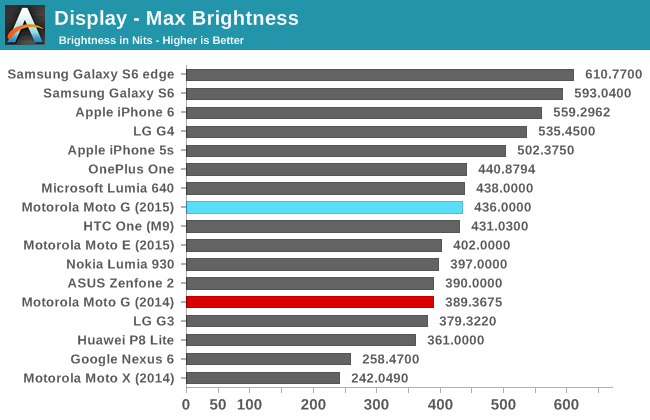
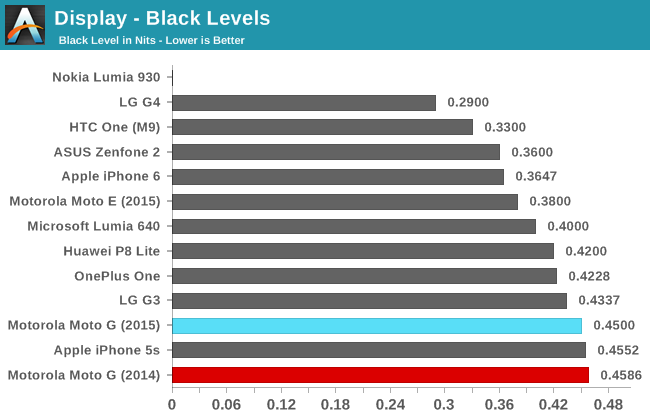
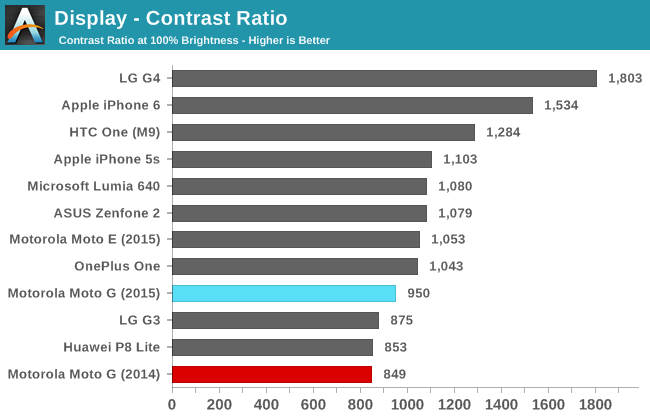
The Moto G has a good peak brightness, although the black level is higher than most recent devices, including the 2015 Moto E. What makes the Moto G somewhat difficult to use outdoors despite its brightness is the fact that the display seems fairly reflective, and the capacitive touch sensors show up very easily in the light which creates a pattern that obscures the content on the LCD.
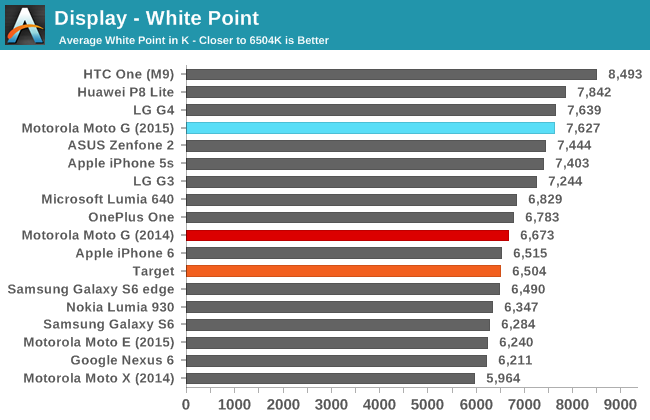
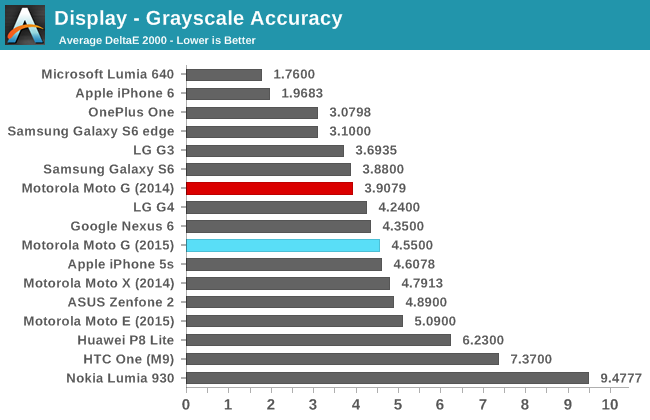
The Moto G's gamma is very accurate, but the overall greyscale accuracy is let down by the panel's blue shift. The white point average is 7627K, which is noticeably more blue than the desired average of 6504K. From 20% grey onward one can notice the blue tint in grey shades, and in the end the average error is a somewhat disappointing 4.5532, with the error in the lightest shades being even higher at around six. In all of these aspects, the 2015 Moto G's display actually regresses significantly from the 2014 model. It's not clear if this is just model variance, or if this is applicable to all versions, but in any case it is disappointing.
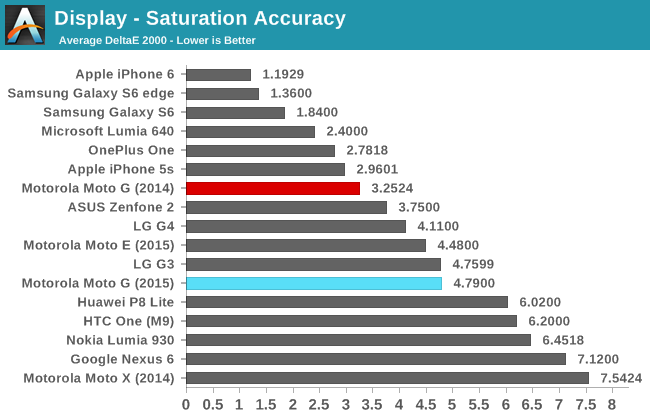
In our saturation sweep test we see that blue has a degree of over-saturation at all points, with saturations past 60% overshooting significantly. Red demonstrates some saturation compression, and there's general inaccuracy in yellow, cyan, and most of all, magenta. This is another situation where the 2015 Moto G's display regresses compared to the 2014 edition, and it's to a much more significant degree than the greyscale test, with the older 2014 Moto G having achieved a result that rivals high end smartphones.
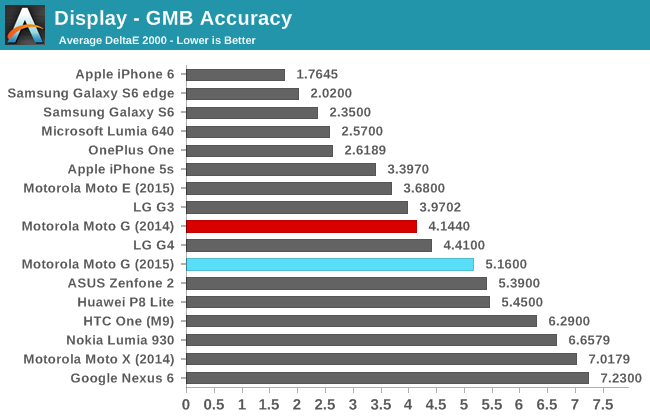
Due to the inaccuracy in the greyscale and in rendering primary and secondary colors there's not much hope for accurate reproduction of color mixtures on the 2015 Moto G's display. Shades of green tend to have a decent level of accuracy, but most other colors and shades of grey suffer from over-saturation or under-saturation depending on what primary/secondary color they most relate to, and are just generally inaccurate. When using the Moto G this was fairly evident to me throughout the UI, particularly on icons that I see very often such as those for Google's own apps.
While I don't know how consistent the calibration across Motorola's devices is, based on the results measured for our samples of the 2014 and 2015 Moto G it's clear that the display of the 2015 model regresses in most respects. Peak brightness increases substantially which is appreciated, and maintaining black level has boosted contrast. Unfortunately, the display is far too blue, and this causes significant greyscale errors despite the display's relatively straight and accurate gamma. The inaccuracies in rendering primary and secondary colors combined with the greyscale errors means that there aren't many shades the display actually does render accurately outside of some that primarily consist of a green component. Ultimately I'm let down by the Moto G's display, because this year's model saw no upgrade to resolution, and I had hoped that there would be some improvement, or at the very least no reduction in the display accuracy.


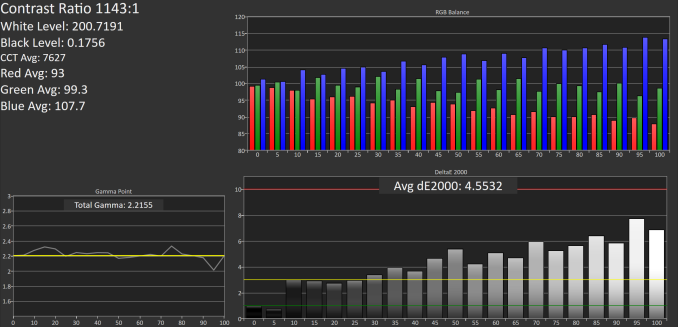

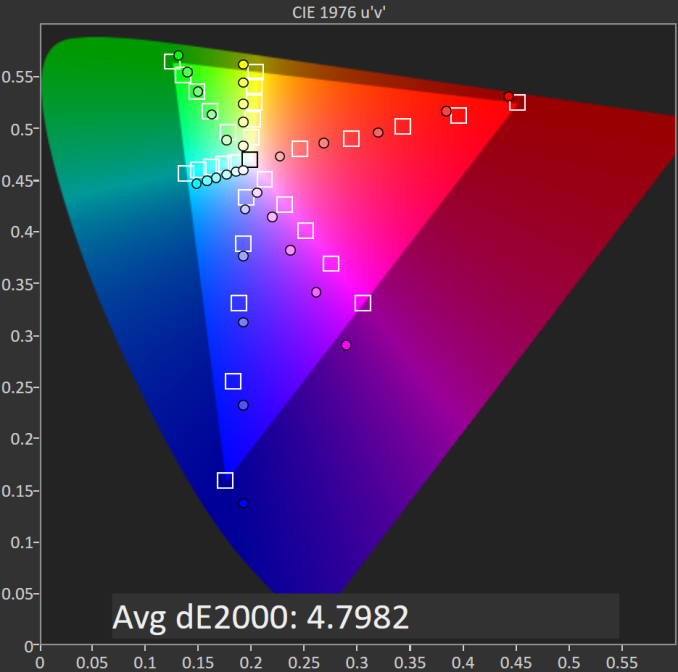










90 Comments
View All Comments
shadarlo - Monday, August 24, 2015 - link
While the G2 is a great phone that I've had since nearly the launch, I am VERY ready for a new phone. I just don't see too many in this generation worth buying.For $175 or so that the G2 can be had for on sales it definitely blows away the current mid-tier phones.
phoenix_rizzen - Tuesday, August 25, 2015 - link
Except that managing iOS devices is a royal pain in the arse that requires bucketloads of money spent on software, hardware, and tech time. When a school district *needs* a full-time person (usually 2-3 if you want any kind of fast turn-around) doing nothing but managing iOS hardware and software, there's something wrong with the management tools. Apple Configurator is a joke. The MDM tools from various sources aren't much better. Any way you cut it, iOS device management is a time consuming money pit.Android management isn't much better, and the tools are very basic, but they are improving. The biggest problem is that what works for OEM X doesn't always work for OEM Y, and what works for Device A from OEM X doesn't always work for Device B from the same OEM. :( If you standardise on a single device from a single OEM, things aren't too bad.
Have no experience with BB10 or WinPhone management.
ChromeOS is really the only one that is easy to manage, even using the free tools from Google. As much as I dislike Chromebooks in general, the management tools are light-years ahead of anything available for the other mobile devices. (Unless you can afford 6-digit yearly licensing fees, in which case there's MDM software that comes close.)
Even with the horrible management tools, dealing with Android devices is still much better than dealing with iOS devices. We tolerate them on our networks; but we do everything we can to discourage people from buying them.
RaLX - Wednesday, August 19, 2015 - link
BTW, I would wait for the Nexus 5 before making any decision.mmrezaie - Wednesday, August 19, 2015 - link
Google usually messes the battery life so much. I bought the new moto e for the sole purpose of battery life, but it has some issues of its own.Pissedoffyouth - Wednesday, August 19, 2015 - link
No, installing crap like Greenify and things makes people whinge about battery life. Everyone who complains always runs these "battery saving 5000" apps and wonder why their phones are crap?Solandri - Wednesday, August 19, 2015 - link
The battery in my 2013 Nexus 5 began dying prematurely. It'd start off the day at 100%, get to 50% by around 3pm, then it'd go from 50% to dead in the next hour. Google eventually replaced it with a new phone under warranty. But as part of the troubleshooting process, they asked me to do a rundown test with the phone in safe mode. Safe mode disables all apps and services which weren't installed on the phone by default. All the default functions (phone, camera, etc) still work.The damn thing lasted just shy of 3 days even with a bad battery. It's made me seriously reconsider what apps I install on my phone.
eek2121 - Thursday, August 20, 2015 - link
Get an HTC One M8. Install CM12.1 on it. Even on stock I was getting 24 hours on a charge, and i'm a heavy user, browsing the internet for hours every day. Love this phone.Devo2007 - Sunday, August 23, 2015 - link
I've always wondered what effect Greenify, Amplify, etc really have on battery life. Sure, sometimes random wakelocks can impact battery life, but unless someone is specifically seeing something draining the battery if makes me wonder if these apps do more harm than good.Devo2007 - Sunday, August 23, 2015 - link
... Of course, the moment I express concerns like this, I usually tend to get shot down pretty quickly as someone who has no idea what I'm talking aboutmmrezaie - Wednesday, August 19, 2015 - link
I meant for Nexus phones.